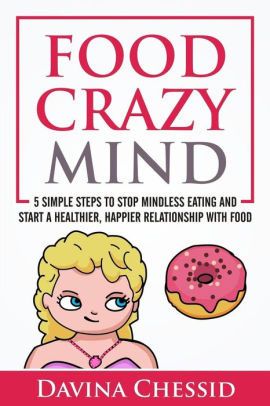
The struggle to find a healthy relationship with food is a reality for many people. Faced with daily decisions such as how much, when, what, and why, navigating just what a healthy eating practice actually looks like is not as simple as magazine covers and self-help books would like us to believe. That is why Food Crazy Mind: Five Simple Steps To Stop Mindless Eating And Start A Healthier, Happier Relationship With Food, this easy to read and relate to autobiographical reflection by Davina Chessid, is so refreshing.
How the book is organized
Chessid, a personal development and life coach, offers five simple steps that can help readers break the cycle of mindless eating and gain some more control over their impulses, cravings, and underlying causes of overeating. Personal journal entries make up a large part of the book, providing humorous anecdotes and very relatable storylines that illustrate just how we are all just doing our best along this journey.
Introduction
“For most of us, the first step is the hardest. But the foundation of real change – change that is lasting and authentic – is self-awareness. It’s the result of choosing to hear and honor the voice of your own Food Crazy Mind.”
Chessid sets the stage for a personal, intimate and thoughtful journey through the inner workings of one who has lost control of their relationship with food. She found that writing helped her get through feelings of being stuck, confused, and lost when it came to making healthy food choices.
Food Crazy
Rather than a simple path of diet to weight loss, Chessid found that the more she dieted, the more weight she gained and the more complex the path became. She struggles with wanting to stay overweight to harness some control, while wanting to try everything to get the extra pounds off. Following her doctor’s suggestion, she starts to try to notice her feelings, because “awareness is the first step.
Step One - Exploring Resistance
The feelings of being stuck and overwhelmed by shifting to a healthier eating routine can originate in resisting change, not due to not wanting it, but because of underlying emotions. Chessid asks the reader to “think about what would happen if you had a healthy relationship with food. How would life be different? What if you were at a healthy weight? If we want to change, we have to first find the vocabulary, so that we know what we are up against and can begin to think about the changes we want to make. “Perhaps it is the fear of failure, success, the unknown, or of deprivation? She presents the fear of loss as a category all its own, including the fear of losing oneself, connection, safety, or freedom.
Within the struggle of weight loss, there are also secondary gains that one achieves, such as the belief that food helps to manage unmanageable emotions, it is an enjoyable way to fill time, and weight is a great excuse for hiding. Just looking at this resistance honestly and directly is a huge first step.
Step Two – Introducing Mindfulness
“Mindfulness is the state of being aware: not just aware but actively aware, aware on purpose. It starts with a willingness to know the truth and to stop judging yourself – or your feelings or behaviors.”
Mindfulness, or being fully present in the present moment, is a key tool that Chessid addresses in her book. Rather than looking at yourself and judging what you see, giving yourself even a short daily moment of undivided and compassionate attention is key to moving out of where you feel stuck. Once you have a better understanding of where you are at and what the blocks and fears might be about, you can try to shift the approach of NOT being able to change to exploring just HOW you might be able to handle the change.
Step Three – Looking at Feelings
“With food, I can pace my feelings and control the speed at which I experience life, so that I’m not overwhelmed. At least, that’s the illusion. Eating is my misguided attempt to protect myself from intolerable feelings.”
Eating is an easily accessible way to touch an emotional need, from dampening unwelcomed emotions or celebrating a success, and over time, these emotions are hard to recognize on their own because they can be mistaken for a general sense of hunger for food rather than a deeper need. When you see that your eating is out of control, Chessid offers the practice of taking a moment to be aware of your rushing to the cabinet again and to ask yourself questions like, “What am I feeling right now? What will really nurture me? Why do I feel this way?” Although at first it might not be easy to name, over time these feelings will be come clear and you chose whether you want to release them or address them directly.
Step Four – The Power of Habit
“If willpower is a muscle, I just can’t do the heavy lifting. I resist temptation easily the first time, less so the second; my willpower decreases by leaps and bounds after that, until I really do believe that just one piece of cake is fine – even though I know I won’t stop at one piece. It’s as though I’m holding my breath and I can’t exhale until I’ve eaten it all”
We all have our own ways of doing things, our tried and true path to work, routine at bedtime, or pleasant associations with certain smells and tastes. Those neural pathways are well established and shifting what we are comfortable doing takes extra effort and energy. Starting to identify eating habits that are not healthy and working in a mindful way to shift the auto-pilot can gradually rewire your brain to consider another way. Chessid offers some starting questions, such as “What could I do differently? Is there any way to change one link in the sequence of events?” By focusing on changing behavior with a compassionate outlook rather than the long term goal of weight loss with a constant sense of failure, every little success with increase your faith in your ability to meet the challenges in your life.
Step Five – The Significance of Self Image
“When you keep repeating the same negative messages, after a while you being to believe them. But… the same is true of positive messages.”
Having a negative self-image makes us feel undeserving of good things, be it love, financial success, respect, or anything positive really. This can include health and feeling good in our physical bodies. Luckily for us, our self-image is shaped by ourselves, meaning that we can work towards gaining more control of just how we speak to ourselves and beginning to integrate positive messages. Letting go of perhaps a negative self-image can help to open up the possibility of a healthier, nourishing, and supportive relationship with food. Integrating an approach of mindfulness, one can observe the negative inner voices and start to add positive reinforcements over time.
Conclusion
While still struggling with emotional eating, Chessid shares that the practice of mindfulness has given her an invaluable tool to use while navigating this struggle. She writes,
“There are many things we can’t control in life, but taking responsibility for what we can control and working to change what we can change is a huge success. For the most part, I’m not (now?) paying attention – and even though I may not always like what I see, I’m happier, more hopeful, and more at peace with myself.”
Recommendation
Food Crazy Mind is a short, rich, and digestible book about a topic that can be very triggering and heavy. As someone who has struggled with my own relationship with food, I greatly appreciated being able to see myself in her stories and to find numerous nuggets of wisdom throughout her journal entries and concrete steps. I think it is a great book to share with friends and especially to offer to younger women who are wanting to take some concrete steps to distance themselves from their own struggles with compulsive eating, over-eating, binge-eating or emotional eating.
This book is 134 pages.
Reviewed by Helaine Alon, ZBC Communication Coordinator


